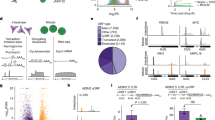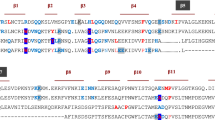Summary
The molecular characterization of the first example of null allele in the inter-alpha-trypsin inhibitor H1 (ITIH1) system,ITIH1*Q0 iwate, encountered as apparent inverse homozygosity of ITIH1 phenotypes between mother and child in a paternity case, is described. Single-strand conformation polymorphism analysis and subsequent sequencing showed that deletion of a single nucleotide in the codon for Lys87 results in a frameshift causing a terminator codon downstream of the deletion. This leads to premature termination of ITIH1 protein translation at amino acid 128, resulting in a truncated protein.
Similar content being viewed by others
Log in or create a free account to read this content
Gain free access to this article, as well as selected content from this journal and more on nature.com
or
References
Bost F, Bourguignon J, Martin J-P, Sesboüé R, Thiberville L, Diarra-Mehrpour M (1993): Isolation and characterization of the human inter-α-trypsin inhibitor heavy-chain H1 gene. Eur J Biochem218: 283–291
Diarra-Mehrpour M, Bourguignon J, Sesboüé R, Matteï M-G, Passage E, Salier J-P, Martin J-P (1989): Human plasma inter-α-trypsin inhibitor is encoded by four genes on three chromosomes. Eur J Biochem179: 147–154
Diarra-Mehrpour M, Bourguignon J, Bost F, Sesboüé R, Muschio F, Sarafan N, Martin JP (1992): Human inter-α-trypsin inhibitor: full-length cDNA sequence of the heavy chain H1. Biochem Biophys Acta1132: 114–118
Ding M, Umetsu K, Yuasa I, Sato M, Harada A, Suzuki T (1995a): Molecular basis of inter-alpha-trypsin inhibitor heavy chain H1 (ITIH1) polymorphism. Hum Genet95: 435–436
Ding M, Umetsu K, Suzuki T (1995b): Detection of ITIH1 types from newborns. Res Pract Forensic Med38: 475–478
Enghild JJ, Thøgersen IB, Pizzo SV, Salvensen (1989): Analysis of inter-α-trypsin inhibitor and a novel trypsin inhibitor, pre-α-trypsin inhibitor, from human plasma. Polypeptide chain stoichiometry and assembly by glycan. J Biol Chem264: 15975–15981
Harada A, Umetsu K, Suzuki T (1994): Inter-alpha-trypsin inhibitor polymorphism. An improved phenotyping procedure and two new alleles. Int J Legal Med107: 25–28
Harada A, Umetsu K, Suzuki T (1995): Genetic polymorphism of the H1 subunit of inter-alpha-trypsin inhibitor. Int J Legal Med108: 113–115
Huang L, Yoneda M, Kimata K (1993): A serum-derived hyaluronan-associated protein (SHAP) is the heavy chain of the interα-trypsin inhibitor. J Biol Chem268: 26725–26730
Nakayashiki N, Tokiwa K, Kumagai R, Katsura S (1994): Human inter-alpha-trypsin inhibitor (ITI) silent allele found in a case of disputed paternity. In: Bär W, Fiori A, Rossi U (eds). Advances in Forensic Haemogenetics 5. Springer-Verlag, Berlin, pp 635–637
Thiberville L, Bourguignon J, Beldjord C, Diarra-Mehropour M, Nouvet G, Martin JP (1994): Detection by the polymerase chain reaction of two polymorphisms in exon 14 of the human inter-α-trypsin inhibitor heavy chain H1 gene. Hum Genet93: 91–92
Vogt U, Cleve H (1990): A “new” genetic polymorphism of a human serum protein: inter-alpha-trypsin-inhibitor. Hum Genet84: 151–154
Vogt U, Cleve H, Farhud DD, Goedde HW (1991a): The ITI system in South Koreans and Iranians analysed by an improved classification procedure. Hum Genet87: 677–679
Vogt U, Weise W, Cleve H (1991b): The examination of the ITI system in disputed paternities. Int J Legal Med104: 201–204
Vogt U, Sesboüé R, Bourguignon J, Diarra-Mehrpour M, Martin JP, Cleve H (1994): The polymorphism of the plasma inter-α-trypsin inhibitor (ITI) and its relationship to the heavy chain H1 subunit gene (ITIH1) at 3p211-212. Hum Genet94: 39–44
Yuasa I, Suenaga K, Saneshige Y, Tamaki N, Ito K, Okada K (1991): Inter-alpha-trypsin inhibitor (ITI): a useful genetic system in paternity testing. Evidence for polymorphic occurrence ofITI*3 and existence of a new allele,ITI*4. Int J Legal Med104: 197–199
Author information
Authors and Affiliations
Rights and permissions
About this article
Cite this article
Nakayashiki, N., Ding, M., Umetsu, K. et al. ITIH1*Q0 iwate, a null allele of inter-alpha-trypsin inhibitor H1 caused by deletion/frameshift mutation. Jap J Human Genet 42, 363–368 (1997). https://doi.org/10.1007/BF02766960
Received:
Accepted:
Issue date:
DOI: https://doi.org/10.1007/BF02766960



